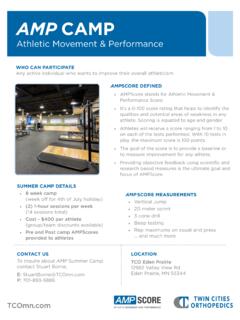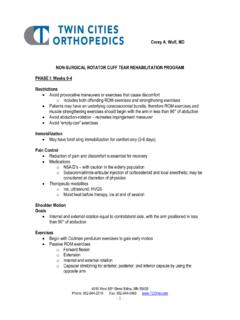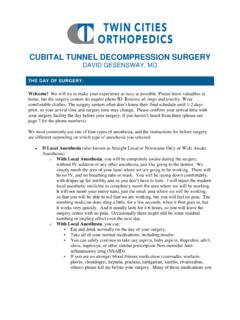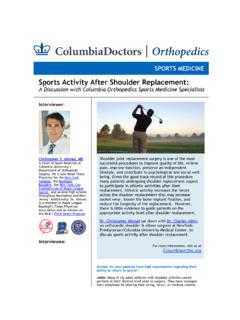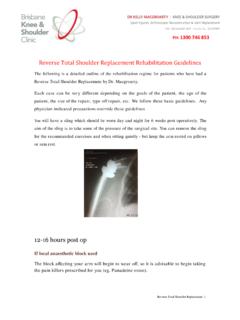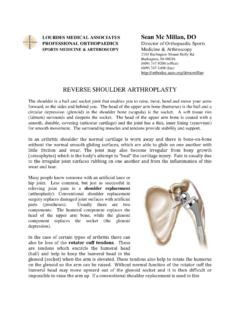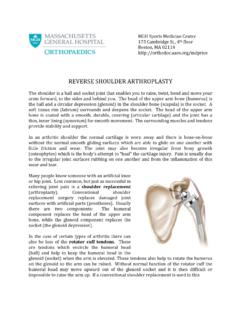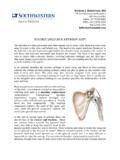Transcription of The Reverse Shoulder Book - tcomn.com
1 Frank Norberg, MDPlymouth West Health2805 Campus Drive Suite 660 Plymouth, MN 55441 Phone #: 763-520-2961 Fax #: 763-550-2979 Twin Cities Orthopedics4010 West 65th Street Edina, MN 55435 Phone #: 952-920-0970 Fax #: 952-920-0148 The Reverse ShoulderReplacementBook THE NORMAL Shoulder WORKS Your Shoulder is the most fl exible joint in your body. It allows you to place and rotate your arm in many positions in front, above, to the side and behind your body. This fl exibility also makes your Shoulder susceptible to instability and injury. The Shoulder is a ball and socket joint. It is made up of three bones: the upper arm bone (humerus), Shoulder blade (scapula) and collar bone (clavicle). The ball at the top end of the arm bone fi ts into the small socket (glenoid) of the Shoulder blade to form the Shoulder joint (glenohumeral joint).
2 The socket of the glenoid is surrounded by a soft-tissue rim (labrum). A smooth, durable surface (articular cartilage) on the head of the arm bone, and a thin inner lining (synovium) of the joint allows the smooth motion of the Shoulder upper part of the Shoulder blade (acromion) projects over the Shoulder joint. One end of the collarbone is joined with the Shoulder blade by the acromioclavicular (AC) joint; the other end of the collarbone is joined with the breastbone (sternum) by the sternoclavicular joint. The joint capsule is a thin sheet of fi bers that surrounds the Shoulder joint. The capsule allows a wide range of motion yet provides stability. The rotator cuff is a group of muscles and tendons that attach your upper arm to your Shoulder blade.
3 The rotator cuff covers the Shoulder joint and joint capsule. The muscles attached to the rotator cuff enable you to lift your arm, reach overhead, and take part in activities such as throwing or swimming. A sac-like membrane (bursa) between the rotator cuff and the Shoulder blade cushions and helps lubricate the motion between these two structures. The Rotator cuff is made up of muscles and tendons that attach your upper arm to your Shoulder . The tendons attach your muscles to the Acromion in the top part of your Shoulder Bursa is a lubricating sac. It helps your rotator cuff tendons slide under the Humerus is your upper arm Glenoid is your Shoulder Deltoid muscle covers your Shoulder . INDICATIONS FOR A Reverse TOTAL Shoulder A Reverse total Shoulder replacement allows treatment of patient s with: rotator cuff tear arthropathy instability with anterosuperior escape psuedoparalysis failure of surgery for arthritis and fracture management.
4 A common indication for a Reverse total Shoulder replacement is called rotator cuff tear arthropathy (see fi gures 1A and B ). This is a condition that causes signifi cant discomfort and declined function of the affected side. These symptoms are caused by the loss of the rotator cuff tendons and deterioration of the Shoulder s normal joint surface cartilage (arthritis). The instability of the joint, caused by the loss of the rotator cuff and arthritis, cause the pain and loss of movement. Other indications for a Reverse procedure are failure of a conventional Shoulder replacement or failed fi xation of a fracture. Reverse Shoulder replacement The Reverse total Shoulder replacement was fi rst used in US in 2005, but it has been used in Europe since the 1980 s and has shown to restore motion, give pain relief and increase stability.
5 The Reverse total Shoulder procedure is generally used in individuals who are 60 years old or older and who are experiencing signifi cant pain and little to no range of motion. This procedure is not appropriate for younger orphysically active individuals. Normal Shoulder anatomy allows the rotator cuff tendons to help balance the ball of the arm (humeral head) in thesocket against the upward pull of the deltoid muscle. In the presence of rotator cuff arthropathy, the cuff tendonsbetween the humeral head and the overlying bone (acromion) become progressively thinned until the humeral headmoves upward and rubs against the acromion. FIGURE 1 A AND BReverse total Shoulder surgery continues to evolve over time. Current techniques have resulted in good to excellentoutcomes in the majority of patients.
6 Almost all patients have marked pain relief. The majority of patients will alsohave improvement in the function of their Shoulder , but this is less predictable. The Reverse total Shoulder replacement is a mechanical device (fi gure 3 A and B) and is expected to have wear and tear with time and use. Most Reverse total Shoulder replacements are expected to last 10-15 years. Individuals who have weakening and loss of function from rotator cuff arthropathy need to have their Shoulder re-aligned. To do this, the Reverse total Shoulder prosthesis is designed with a socket where the ball (humeral head)is normally located and a ball where the socket (glenoid) is normally located ( fi gure 2 A and B).
7 Changing the confi guration of the Shoulder provides more stability and a fulcrum against which the deltoid muscle can help elevatethe Shoulder and return some basic Shoulder function. FIGURE 2 A AND B FIGURE 3A AND BBEFORE SURGERYA preoperative physical exam will be performed by your primary physician to assure that you are ready for surgery. This can be done up to 1 month prior to will need to stop anti-infl ammatory medications (Advil, Ibuprofen, Motrin, Aleve, and aspirin) 5 days prior to surgery unless cleared with Dr. needs to be stopped 10 days prior to surgery. Coumadin (warfarin) use needs to be stopped as well. Discuss this with your primary physician and Dr. Norberg. Stopping Coumadin requires the direct supervision of your primary care your usual medications on the morning of surgery with a small sip of a current list of your medications to the visit with your dentist is recommended.
8 Poor dental health or cavities greatly increase the risk for infection of the Reverse Shoulder replacement with catastrophic SURGERYYou will be place in a sling after surgery. This is to be worn the fi rst 4 weeks. The sling is to be removed for dressing, bathing and exercises. It should be removed when eating, grooming and for table top actives. Most people will be in the hospital for 2 days following their surgery. This may vary depending on your specifi c dressing will be placed at the time of surgery and will be removed the second post-operative day. A new dressing can be applied if there is drainage at the may shower beginning the 3rd post-operative day. The incision is allowed to get wet when showering, but the incision should not be submerged for a minimum of 2 very careful on stairs and with actives as a fall or overuse in the early postoperative period may irreversibly damage your Reverse Shoulder a follow-up appointment 7-10 days after surgery.
9 Initial follow up visits are with Dani Hare PA-C. Dr. Norberg s physician tape strips (steri-strips) will be in place over the incisions. Leave these in place until they fall off. Usually this is 10-14 RELIEFP ercocet (oxycodone/acetaminophen) and Vicodin (hydrocodone/acetaminophen) are the commonly prescribed pain medications. They should only be used as directed. Exceeding the recommended dose or taking them with alcohol may result in liver damage, serious injury or possibly relief can be improved with the use of anti-infl ammatories (Advil, Aleve, and Ibuprofen). These can be taken in-between your prescription pain medications. Regular icing of the Shoulder for 20 minute periods can be helpful. Do not take your pain medications unless you need them as they may cause nausea or patients fi nd it more comfortable to sleep in a recliner or propped with pillows for the fi rst several you are running out of pain medications be sure to call the offi ce between 8:30 and 4:00 PM.
10 Pain medications are not fi lled after hours or on OF SURGERYAll surgeries have associated risks. These include but are not limited to anesthetic complications, infection, artery or nerve injury. The surgery generally resolves pain at rest and improves function, but a normal Shoulder is not expected. Full pain relief may not be achieved. Late loosening of the prosthesis is also a risk. QUITTING SMOKINGS moking or using any form of nicotine or tobacco products (including cessation products), can delay your body s healing process. Smoking makes your blood vessels constrict (become smaller), which reduces the amount of oxygen-rich blood in your bloodstream. Smoking can cause your blood to clot faster, which can lead to heart and blood fl ow problems.




